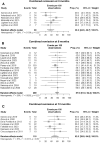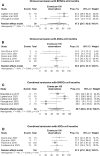Efficacy of mesenchymal stem cell-based therapies in the treatment of perianal fistulizing Crohn's disease: a systematic review and meta-analysis
- PMID: 40156066
- PMCID: PMC11951560
- DOI: 10.1186/s13287-025-04272-y
Efficacy of mesenchymal stem cell-based therapies in the treatment of perianal fistulizing Crohn's disease: a systematic review and meta-analysis
Abstract
Background: Perianal lesions of Crohn's disease (CD) are complex and disabling conditions. Mesenchymal stem cell (MSC)-based therapies have emerged as an innovative approach in managing refractory perianal fistulizing CD. We conducted a systematic review and meta-analysis to describe and compare combined remission and clinical outcomes of MSC-based therapies, and then whether one approach stands out from the rest.
Methods: We searched in MEDLINE, EMBASE and CENTRAL (up to December 31, 2023) all prospective studies assessing a local injection of MSC-based therapy in perianal fistulas of CD. The primary outcome was achievement of combined remission. MSC-based therapy strategies were compared.
Results: Twenty-five studies were included in the meta-analysis, enrolling 596 patients with perianal fistulizing CD. The combined remission rate at 3, 6 and 12 months were 36.2% (95% confidence interval (CI), 24.5-49.7), 57.9% (95% CI 51.3-64.2) and 52% (95% CI 38.8-64.8), respectively. MSC-based therapies demonstrated a significant effect in achieving combined remission compared to placebo at 3 months (relative risk (RR) = 1.6; 95% CI 1.0-2.8) and at 6 months (RR = 1.5; 95% CI 1.1-1.9). At 6 months, the combined remission rate was 57.2% (95% CI 47.2-66.6) for adipose-derived stem cells (ASCs) and 55.7% (95% CI 26.4-81.5) for bone marrow-derived stem cells (BMSCs). In the network meta-analysis, allogeneic ASCs and BMSCs did not demonstrate superiority over each other (RR = 0.74; 95% CI 0.31-1.77).
Conclusion: MSC-based therapies are effective for achieving combined remission of refractory and/or complex perianal fistulizing CD. The optimal efficacy effect is reached after 6 months of treatment. No superiority has yet been demonstrated between ASCs and BMSCs therapies.
Keywords: Crohn’s disease; Fistula; Mesenchymal stem cells; Meta-analysis; Stromal vascular fraction.
© 2025. The Author(s).
Conflict of interest statement
Declarations. Ethics approval and consent to participate: Not applicable. Consent for publication: All authors have given their consent for publication. Competing interests: L Guillo received lecture and/or consulting fees from Abbvie, Amgen, Ferring and Janssen. JM received honorarium for educational support from Fidia, Horiba and Macopharma. The remaining authors declare no conflict of interest.
Figures





References
-
- Torres J, Mehandru S, Colombel JF, Peyrin-Biroulet L. Crohn’s disease. Lancet. 2017;389:1741–55. - PubMed
-
- Panés J, Rimola J. Perianal fistulizing Crohn’s disease: pathogenesis, diagnosis and therapy. Nat Rev Gastroenterol Hepatol. 2017;14:652–64. - PubMed
-
- Wewer MD, Zhao M, Nordholm-Carstensen A, Weimers P, et al. The incidence and disease course of perianal Crohn’s disease: a Danish nationwide cohort study, 1997–2015. J Crohns Colitis. 2021;15:5–13. - PubMed
-
- Molendijk I, Nuij VJAA, van der Meulen-de Jong AE, van der Woude CJ. Disappointing durable remission rates in complex Crohn’s disease fistula. Inflamm Bowel Dis. 2014;20:2022–8. - PubMed
-
- Yassin NA, Askari A, Warusavitarne J, et al. Systematic review: the combined surgical and medical treatment of fistulising perianal Crohn’s disease. Aliment Pharmacol Ther. 2014;40:741–9. - PubMed
Publication types
MeSH terms
LinkOut - more resources
Full Text Sources
Medical

